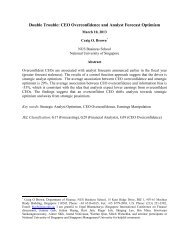bias_2014_report_technical_supplement
bias_2014_report_technical_supplement
bias_2014_report_technical_supplement
Create successful ePaper yourself
Turn your PDF publications into a flip-book with our unique Google optimized e-Paper software.
1. RemindersThe use of reminders involves prompting program participants by supplying a specific piece of informationto make it noticeable and to increase the chances that participants will act on that information.Reminders can have dramatic effects on behavior, such as encouraging people to get critical medicaltests, quit smoking, and pay their bills on time. 5 In all these cases, the individual must remember to takeseveral steps in order to follow through on an intention, and it is easy to forget or neglect to take one ofthose steps. A timely reminder may prevent this problem. A simple, regular text-message reminder to savemoney, for example, increased savings balances by 6 percent in a randomized controlled trial. 6Practitioners can deliver reminders through multiple channels. The context of the problem shoulddetermine the format and timing of the reminder. For example, consider a reminder regarding a deadline.If it is delivered too close in time to the deadline, it might not provide the individual with enough time toprepare; if delivered too far in advance, it may be forgotten before the deadline arrives.2. Social InfluenceSocial influence can be used to directly or indirectly foster a particular type of behavior through direct orindirect persuasion.Comparing an individual’s conduct with that of peers, neighbors, or friends is an effective way tochange behavior. For example, sending mailers to households comparing neighbors’ electricity consumptionand rating each household as great, good, or below average led to a reduction in power consumptionequivalent to what would have resulted if energy prices had been raised 11 to 20 percent, with effectstwice as large for those who were initially using the most electricity. 7 Similarly large effects have beenfound for water consumption, where comparison with neighbors’ usage curbed consumption far more thanproviding basic or general facts on how best to reduce water use. 8This approach should originate with a person known to the individual who is the target of the desiredbehavioral change (for example, a friend, family member, or teacher) or, if not known personally, a wellknownpersonality (like a celebrity or a public official). The person who is trying to influence the behaviorestablishes the guidelines for socially appropriate and inappropriate conduct. The effect need not be conscious,as in the case of children mimicking their parents’ behavior.3. FeedbackProviding ongoing information — or feedback — to individuals about their behavior is a way to make thatinformation salient and allow the individuals to evaluate their own behavior and change it.Providing feedback at regular intervals makes it easier for individuals to monitor and regulate theirbehavior. People are sometimes shocked by how much weight they gain during the holidays or by howlittle money they have left in their bank account at the end of the month because they have not receivedany regular feedback about the behavior that led to those outcomes. Receiving feedback on progresstoward goals, at regular intervals, helps individuals to meet those goals. For example, a field experimentin California provided individualized feedback about participation in a curbside recycling program.Households that were receiving feedback increased their participation by 7 percentage points, while thecontrol group, which received no feedback, experienced no increase. 94. Channel and Hassle FactorsA channel factor can make a behavior easier to accomplish; a hassle factor makes a behavior more difficultto accomplish.Seemingly trivial tasks like waiting in line, filling out a form, or mailing an envelope can have outsizedeffects — they often halt progress altogether, increasing the chance that someone will drop out ofa program midway, or fail to enroll in the first place. Eliminating these “hassle factors” — for example,5 Lantz et al. (1995); Rodgers et al. (2005); Cadena and Schoar (2011).6 Karlan, McConnell, Mullainathan, and Zinman (2010).7 Allcott (2011).8 Ferraro and Price (2011).9 Schultz (1999).commonly Applied Behavioral Interventions 3







